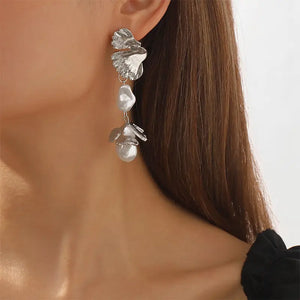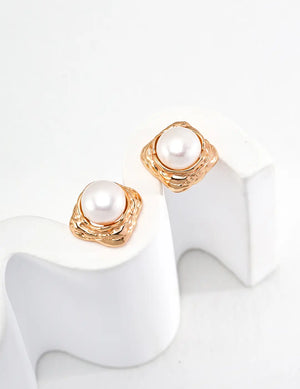Pearls are one of the most elegant and timeless gemstones, loved for their natural beauty and sophistication. However, not all pearls are the same. The primary distinction lies in whether they are freshwater pearls or saltwater pearls. Both types have unique characteristics, ranging from their formation process to their value, making it essential for buyers to understand these differences before making a purchase.
In this guide, we will explore the formation, quality, pricing, durability, and best uses of freshwater and saltwater pearls to help you determine which type suits your needs best.
🔗 Shop Our Exclusive Pearl Collection
How Are Freshwater Pearls and Saltwater Pearls Formed?
Pearls are formed inside mollusks when an irritant, such as a piece of shell or sand, gets trapped inside. The mollusk secretes layers of nacre (a smooth, iridescent substance) around the irritant, gradually forming a pearl. While this process is the same for both freshwater and saltwater pearls, there are key differences in their formation environments and cultivation techniques.
Freshwater Pearl Formation
Freshwater pearls are primarily cultivated in rivers, lakes, and ponds, with China being the leading producer. Unlike saltwater pearls, which develop in oysters, freshwater pearls are formed inside mussels.
- Farmers can cultivate multiple pearls inside a single mussel (sometimes up to 50 pearls at once).
- Freshwater pearls take 2-6 years to develop.
- These pearls tend to have varied shapes—round, oval, baroque, or button-shaped—due to the way they form inside the mussel.
Saltwater Pearl Formation
Saltwater pearls are found in oceans and seas, cultivated in countries like Japan, Australia, and the Philippines. Unlike freshwater pearls, saltwater pearls are grown inside oysters, and each oyster typically produces only one pearl at a time.
- The most common saltwater pearls include Akoya, Tahitian, and South Sea pearls.
- The formation process can take 4-7 years due to the controlled environment needed for high-quality pearls.
- Saltwater pearls generally have a rounder shape and a more intense luster compared to freshwater pearls.
Key Differences Between Freshwater Pearls and Saltwater Pearls
| Feature | Freshwater Pearls | Saltwater Pearls |
|---|---|---|
| Origin | Lakes, rivers, ponds | Oceans, seas |
| Luster | Softer, satin-like shine | Higher, mirror-like shine |
| Shapes | Baroque, oval, off-round | Mostly round & uniform |
| Durability | More resistant to wear | Softer nacre, more delicate |
| Price | More affordable | Higher due to rarity |
| Common Types | Freshwater pearls | Akoya, Tahitian, South Sea pearls |
Quality & Luster: Which Type of Pearl Looks Better?
The beauty of pearls largely depends on their luster, which is the reflection and glow that makes them shine. Luster is one of the key indicators of a pearl’s quality, and it varies between freshwater and saltwater pearls.
Luster & Surface Quality of Freshwater Pearls
Freshwater pearls generally have a soft, satiny luster, giving them a natural and organic appearance. Since they are composed almost entirely of nacre, their surface is durable and less prone to flaking or peeling.
However, due to the natural growth process, freshwater pearls:
- Often have less consistent shapes (oval, off-round, or baroque).
- May contain more surface blemishes, though high-grade freshwater pearls can still be very smooth.
- Are thicker than saltwater pearls, making them more resistant to wear.
Luster & Surface Quality of Saltwater Pearls
Saltwater pearls are highly prized for their brilliant, mirror-like luster. Since they take longer to form, the nacre layers are thinner, resulting in a sharper reflection and a more defined glow.
Compared to freshwater pearls, saltwater pearls:
- Are usually rounder and more symmetrical.
- Have a higher gloss, making them more valuable.
- Are more delicate, requiring careful handling to prevent damage.
For those looking for a strong shine and a luxurious feel, saltwater pearls are the better choice. However, if durability and affordability are priorities, freshwater pearls remain an excellent alternative.

Price Comparison: Which Type of Pearl is More Affordable?
-
Price is a crucial factor when purchasing pearls. While both types offer beautiful options, freshwater pearls are significantly more affordable than saltwater pearls.
Why Are Freshwater Pearls Cheaper?
- Mass Production: Freshwater mussels can produce multiple pearls at once, lowering production costs.
- Shorter Cultivation Time: Freshwater pearls develop faster, making them more widely available.
- Varied Quality Levels: While some freshwater pearls have high luster, most are not as flawless or round as saltwater pearls.
Why Are Saltwater Pearls More Expensive?
- Limited Production: Saltwater oysters produce only one pearl per oyster, increasing their rarity.
- Higher Demand: Saltwater pearls, especially Akoya and South Sea pearls, are associated with luxury and prestige.
- Intensive Farming Process: Saltwater pearls take years to form, and their maintenance is more complex.
- A freshwater pearl necklace may range from $50 to $500.
- A high-quality Akoya pearl necklace may start at $500 and go up to $5,000.
- South Sea pearls, the most valuable saltwater pearls, can cost $1,000 to over $10,000.

Durability & Longevity: Which Pearls Last Longer?
When investing in pearl jewelry, it’s important to consider durability. Since pearls are organic gemstones, they require proper care to maintain their shine.
Freshwater Pearls & Durability
- Have thicker nacre layers, making them more resistant to chipping and wear.
- Less prone to flaking, making them ideal for daily wear.
Saltwater Pearls & Durability
- Have thinner nacre layers, making them more delicate.
- Require proper storage and maintenance to prevent scratches.
If you’re looking for pearls that can withstand daily wear, freshwater pearls are the more durable option. However, if you’re purchasing pearls for special occasions or investment, saltwater pearls are worth the extra care.
Which Pearl Type is Best for You?
Choosing between freshwater pearls and saltwater pearls depends on your style, budget, and purpose.
- Choose Freshwater Pearls if:
- You want affordable, everyday pearls.
- You love unique shapes and colors.
- You need pearls that last longer.
- Choose Saltwater Pearls if:
- You prefer high-luster, luxurious pearls.
- You’re looking for investment-grade jewelry.
- You want a classic, elegant piece.
FAQ Section
1. What is the main difference between freshwater pearls and saltwater pearls?
Freshwater pearls are cultivated in lakes and rivers, while saltwater pearls are grown in oceans. Saltwater pearls are usually rounder and have higher luster, while freshwater pearls are more affordable and durable.
2. Are saltwater pearls more valuable than freshwater pearls?
Yes. Saltwater pearls like Akoya and South Sea pearls are more valuable due to their higher luster, round shape, and rarity.
3. Can you wear freshwater pearls every day?
Yes, freshwater pearls have thicker nacre and are more durable, making them perfect for daily wear.
4. Which pearls are best for wedding jewelry?
For bridal jewelry, Akoya pearls are a popular choice due to their classic round shape and high luster.
5. How do you take care of pearl jewelry?
Store pearls separately in a soft pouch, keep them away from harsh chemicals, and clean them with a soft cloth after wear.
Elevate Your Style with Timeless Pearls ✨
Discover the elegance of handcrafted freshwater and saltwater pearls. Whether you're looking for a classic pearl necklace, modern pearl earrings, or a unique statement piece, explore our exclusive collection.
🔗 Shop the Pearl Collection Now
Find the perfect pearl jewelry to match your style today!




